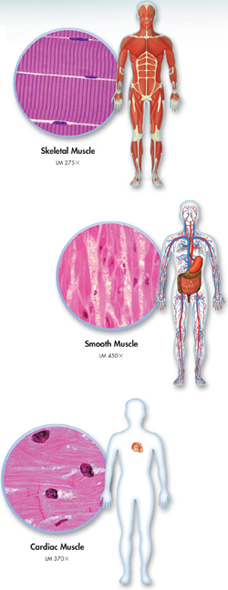Skeletal Muscles Skeletal muscles are usually attached to bones. They are responsible for such voluntary movements as typing on a keyboard, dancing, or winking an eye. When viewed under a microscope at high magnification, skeletal muscle appears to have alternating light and dark bands called “striations.” For this reason, skeletal muscle is said to be striated. Most skeletal muscle movements are consciously controlled by the central nervous system (the brain and spinal cord).
Skeletal muscle cells are large, have many nuclei, and vary in length. The shortest skeletal muscle, which is about 1 millimeter long, is found in the middle ear. The longest skeletal muscle, which may be as long as 30 centimeters, runs from the hip to the knee. Because skeletal muscle cells are long and slender, they are often called muscle fibers.

FIGURE 32–6 Muscle Tissue The three types of muscle tissue look different under a microscope, but all muscle tissue has the ability to produce movement. Compare and Contrast What is the key difference between control of skeletal muscle contraction and smooth muscle contraction?
Smooth Muscles Smooth muscle cells are so named because they don't have striations and, therefore, look “smooth” under the microscope. These cells are spindle-shaped and usually have a single nucleus. Smooth muscle movements are usually involuntary. They are found throughout the body and form part of the walls of hollow structures such as the stomach, blood vessels, and intestines. Smooth muscles move food through your digestive tract, control the way blood flows through your circulatory system, and even decrease the size of the pupils of your eyes in bright light. Powerful smooth muscle contractions are also responsible for pushing a baby out of its mother's uterus during childbirth. Most smooth muscle cells can function without direct stimulation by the nervous system. The cells in smooth muscle tissue are connected to one another by gap junctions that allow electrical impulses to travel directly from one muscle cell to a neighboring muscle cell.
Cardiac Muscle Cardiac muscle is found in just one place in the body—the heart. It shares features with both skeletal muscle and smooth muscle. Cardiac muscle is striated like skeletal muscle, although its cells are smaller and usually have just one or two nuclei. Cardiac muscle is similar to smooth muscle because it is not under the direct control of the central nervous system. Like smooth muscle cells, cardiac muscle cells can contract on their own and are connected to their neighbors by gap junctions. You will learn more about cardiac muscle and its role in the function of the heart in Chapter 33.
Table of Contents
- Formulas and Equations
- Applying Formulas and Equations
- Mean, Median, and Mode
- Estimation
- Using Measurements in Calculations
- Effects of Measurement Errors
- Accuracy
- Precision
- Comparing Accuracy and Precision
- Significant Figures
- Calculating With Significant Figures
- Scientific Notation
- Calculating With Scientific Notation
- Dimensional Analysis
- Applying Dimensional Analysis




